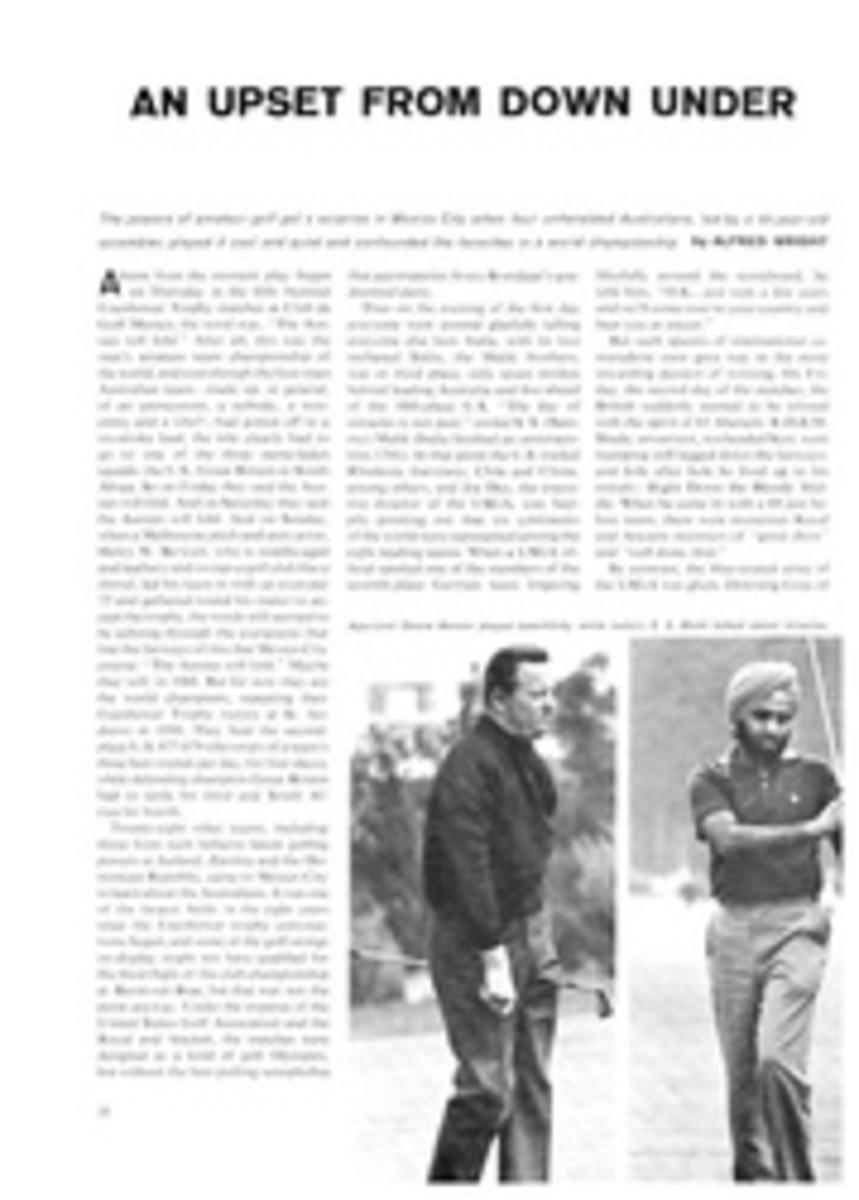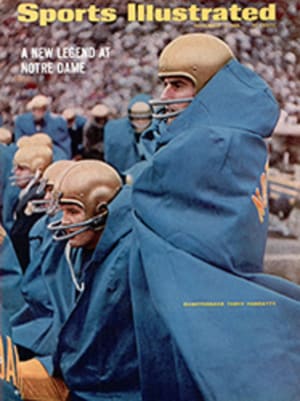
Conning and killing cunning coyotes
Sam Dudley a musical genius of sorts, led the way into the desert, walking with the careful poise of a man who knows exactly where he is going and does not want to step on any rattlesnakes on the way. At dawn the desert resembled an overexposed photograph—the scattered mesquite bushes were blurs of projecting leaves on the outside and black shadows within; the brownish streaks of light on the thin clouds looked like chemical stains in the sky. Sam Dudley and his partner, Hal Perry, a Phoenix builder, were taking part in the fourth annual statewide hunt of the Arizona Varmint Callers Association, an enterprise demanding, among other things, that they remain silent on the way to the stand. A quarter of a mile into the brush Sam found a place he liked. He nodded a direction to Perry, who angled off a hundred feet away, and then the two sat down, facing in opposite directions.
Each had a mesquite bush behind him. For almost five minutes they remained completely silent. The desert became a motionless, windless, soundless world, where even the faint whistle of a bird in a thicket down the draw seemed to be absorbed into the air. Then a series of ghastly shrieks and wails exploded with terrific violence: Dudley blew an opening blast on his varmint call, a short plastic tube with a reed in it. He cupped his hand over one end of the call and moved his lingers to change the sounds that emerged. Meanwhile he vibrated all over with the effort of blowing, his Adam's apple bobbing up and down. The varmint call he was using was supposed to duplicate the sound of a jack-rabbit that had been caught by a coyote. It began with a blare of yah, yah, yah sounds, mounting in violence and tempo, which gave way to gasps, ughs, wails and writhing and gurgling outcries that stopped abruptly, broken off as suddenly as they began.
Again there was absolute silence. Even birdsong was stilled. At close range a varmint call by an expert is well-nigh unbearable. There is no other sound like it. If you are sitting beside a caller when that first blast of horror-laden noise hits you, the shock makes your flesh crawl. However, the effect of a varmint call wears off at once. No matter how skillful the caller is, it does not really sound like an injured rabbit, unless there is some species of rabbit equipped with a police siren. The sound of the call is supposed to carry a mile, and the volume takes it out of the realm of nature and gives it a contrived, mechanical quality, such as might be produced if an infuriated air raid siren pounced on an injured public address system.
Sam Dudley, one of the most experienced of the 600 callers in the Arizona Varmint Callers Association, was born in Oklahoma when it was still Indian Territory. He has hunted in Arizona for 47 of his 69 years. Since he greatly respects the coyote's natural intelligence, he really tries to sound like a rabbit. Now, on his second call, Sam called much more weakly, and for only seven or eight seconds. The imaginary rabbit he was imitating was just about gone. Toward the end of the call, however, a wild, spiraling, grand-opera wail of grief mounted higher and higher and then broke off into a faint squawk, a low bleat.
Silence again, but this time it ended quickly. It ended with a dull blunt thud: Hal Perry shot a coyote. "It's the oddest thing you ever saw," Perry had said, on the way to the stand. "They seem to float right in." You might think that the sound of the shot would scatter all wildlife. But nothing happened. Sam and Hal remained motionless. After five minutes Sam carefully raised his Thompson varmint caller to his lips again. The raucous, squawking, agonized sounds drove away a meadowlark; otherwise nothing moved. A wait of a few more minutes, and Sam called again. This time a coyote materialized directly in front of me. At one instant there was nothing there except a stretch of gray, pebble-strewn sand, framed by a low line of bushes on one side and a little oak, six or eight feet high, on the other. At the next instant a coyote was lounging negligently in the clearing between them. It was about a hundred feet away. There was something ghostly about it, the gray fur blending with the gray sand, as if the coyote had emerged from nowhere. Sam lifted his rifle, inch by inch. The coyote started to cross the cleared space. It changed its mind and moved in slowly along the low bushes, coming straight toward us but looking across the clearing. When the coyote at last turned its head and stared directly at us Sam killed it in a merciful instant as the full horror of its mistake was still dawning.
The fourth statewide Arizona hunt lasted two days. A coyote called in and killed gave a team seven points, a bobcat 20 points. A fox counted for only five. Teams were required to be at the checkpoint, a fiat place by the road near Mammoth, Ariz., by 9:30 p.m. The shooters and the callers were fanned out over an oval-shaped area about 200 miles long and a hundred miles across, ranging from the rocky buttes of the San Carlos Indian Reservation northeast of Globe to the Mexican border near Nogales. As a rule a team made a dozen stands a day. Consequently, they saw a lot of wild country at close range, which is perhaps the greatest appeal of a statewide varmint-calling hunt.
The first club in Arizona was started in 1956, when 26 hunters met in the public library in Phoenix and formed an organization to conserve "wildlife through the taking of predators...with artificial calls." They re also on record as opposing the massive use of poison in predator control. (In 30 years government agencies killed 1,672,604 coyotes, most of them by poison). Now there are varmint-calling clubs throughout Arizona, north central Texas, southern California and scattered organizations in Colorado, Arkansas, South Dakota, Idaho and Utah, with some 3,500 members in all, though there are thousands of unaffiliated callers as well.
The late J. Frank Dobie in The Voice of the Coyote wrote scornfully of men who considered it sport to be "calling up coyotes and shooting them." But Dobie did not know how difficult the call was to master or how many coyotes, once called in, got away. Only 12 teams appeared at Mammoth on the first day of the Arizona hunt; most callers had given up because of breakdowns, flat tires, the heat and the lack of response from the coyotes. The 12 teams accounted for 33 coyotes, two bobcats and one fox. Floyd Preas, a printing technician from Phoenix, and his partner, Pat Turner, had the highest score; they had called in and killed five coyotes and a bobcat. The second day of the hunt was a training session, with experts paired with beginners, and on this day, aside from the two coyotes that Sam Dudley called in, only one coyote was killed.
So there is no real danger that varmint-calling will lead to an indiscriminate slaughter of coyotes. What fascinates these experts about their calling is its unexpectedness: they may call in anything. And even if they call in nothing, they get an unparallelled knowledge of the terrain where they call and they note deer tracks, javalina signs, quail and other game, and plan where they are going to go when the hunting season opens. And meanwhile the coyotes provide an endless source of folklore. Coyotes play dead, disguise themselves, hunt in teams, sing, play jokes and have been known to jump on the flatcars of freight trains to avoid pursuing dogs. They eat almost everything—rabbits, mice, squirrels, gophers, lambs, calves, goats, small pigs, ducks, magpies, crows, buzzards, quail, grasshoppers, grapes, figs, apples, chokecherries, watermelons and, on occasion, other coyotes. At this time of the year in the desert they are well fed, because they also eat mesquite beans, which are now ripe, so hunger is probably not the reason for the temporary foolhardiness that leads them to go for a fake rabbit cry. True, they eat more rabbit than anything else, rabbit meat accounting for 33% of their diet, but in the fall the young rabbits are so plentiful no one can account for the coyote's susceptibility to a ludicrously unlifelike imitation of a rabbit. Nor does there seem to be any difference in intelligence among coyotes; it is not a matter of a dumb coyote coming in and an acute one remaining away. "They're all sharpies," said Sam Dudley. "A bobcat has some features worth looking into. He's so good at this here creeping-up stuff a lot of fellows never see him at all. But a coyote is a different kind of liver. He gets you aimed different. He comes in on the run, or he relies on them wonderful legs he has, them and that head. He's got more gray matter upstairs than a dozen fox."
"You notice that a call doesn't really sound like a rabbit," said Pat Turner. "It would have to be a rabbit seven feet tall to sound like that. But it's a little bit like a rabbit."
Varmint-callers have called in deer, javalinas, horses, cattle, hawks and innumerable dogs. Jack Naperala, the president of the Arizona association, called in an elk, and Dave Niehuis was the first recorded member to call in and kill a bear, an Alaskan wolf and a mountain lion.
"There's no way to express the surprised look on a coyote's face when they come in and see you. You have to see it yourself," said Floyd Preas. "I've got so tickled sometimes, I just stand up to see them get that look on their face when their eyes get big and yellow and they get that tail between their legs and get out of there."
There appears to be no danger of varmint-callers seriously reducing the number of coyotes. But they may be giving these brainiest of wild animals something new to think about.
ILLUSTRATION

